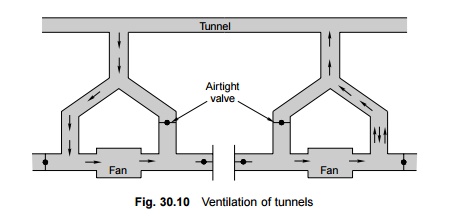Chapter: Civil : Railway Airport Harbour Engineering : Railway Engineering : Railway Tunnelling
Railway Tunnelling: Ventilation of Tunnels

Ventilation of Tunnels
A tunnel should be properly
ventilated during as well as after the construction for the reasons given
below.
(a) To
provide fresh air to the workers during construction.
(b) To remove
the dust created by drilling, blasting, and other tunnelling operations.
(c) To remove
dynamite fumes and other objectionable gases produced by the
use of
dynamites and explosives.
The methods listed below are
normally adopted for the ventilation of a tunnel. These are illustrated in Fig.
30.10.

Natural method of ventilation This is
achieved by drilling a drift through the tunnel from portal to portal.
In most cases natural ventilation is not sufficient and artificial ventilation
is still required.
Mechanical ventilation by blow-in
method In the blow-in method, fresh air is forced through a
pipe or fabric duct by the means of a fan and supplied near the washing face
(or the drilling face; the drilling operation requires the washing of bore
holes too). This method has the advantage that a fresh air supply is guaranteed
where it is required the most. The disadvantage is that the foul air and fumes
have to travel a long distance before they can exit the tunnel and in the
process it is possible that the incoming fresh air will absorb some dust and
smoke particles.
Mechanical ventilation by exhaust
method In the exhaust or blow-out method, foul air and fumes
are pulled out through a pipe and is expelled by a fan. This sets up an air
current that facilitates the entrance of fresh air into the tunnel. This method
has the advantage that foul air is kept out of the washing face. The disadvantage,
however, is that fresh air has to travel a long distance before it can reach
the washing face during which period it may absorb some heat and moisture.
Combination of blow-in and
blow-out methods By combining the blow-in and blow-out
methods using a blower and an exhaust system, respectively, a tunnel can be
provided with the best ventilation. After blasting the ground, the exhaust
system is used to remove the smoke and dust. After some time, fresh air is
blown in through the ducts and the rotation of the fans is reversed to reverse
the flow of air.
Related Topics